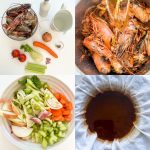
Shellfish Stock
Home made stock beats shop bought stock, each and every time. There is no greater example than this Shellfish Stock – pan frying and cooking the shells from shellfish intensifies and maximises their flavour. Throw in some vegetables, herbs, spices, brandy and wine, and you will find that the depth of flavour you introduce into your dishes, is astounding!
Makes 1½ litres
Ingredients
- 2 – 3 tablespoons olive oil
- 1kg shellfish shells and offcuts – I use shells from langoustine, lobster, prawns, crayfish or shrimp (singularly or a mix), broken into pieces
- 8g/2 cloves of garlic, skin on and slightly smashed
- 150g/½ bulb of fennel, sliced
- 150g/1 large onion, sliced, no need to peel
- 100g/1 medium carrot, trimmed and sliced, no need to peel
- 100g/2 sticks celery, trimmed and sliced
- ¼ teaspoon fennel seeds
- 150g/2 medium tomatoes, chopped
- 2 bay leaves
- 4 – 5 sprigs of fresh herbs such as thyme, parsley, dill, chervil, tarragon
- 90ml/⅓ cup brandy – optional but recommended (replace with water if preferred)
- 250ml/1 cup wine – optional but recommended (replace with water if preferred)
- 2½ litres water (or more if necessary)
Instructions
-
Collect together your equipment (see Recipe Notes below) and ingredients.
-
Heat ½ of the oil in a large pan and cook the shells, over a medium heat, for 10 minutes. They will turn pink as they cook. Stir from time to time.
-
Remove the shells from the pan and set aside.
-
Prepare the vegetables whilst the shells are cooking:
– garlic – slightly crushed, no need to peel
– fennel – sliced
– onion – sliced, no need to peel
– carrot – trimmed and sliced, no need to peel,
– celery – trimmed and sliced.
-
Add the remaining oil and the vegetables (apart from the tomatoes) to the pan and cook over a medium to low heat, for a further 10 minutes. Stir from time to time, until the vegetables have softened and are lightly caramelised.
-
Chop the tomatoes, whilst you cook these vegetables.
-
Add the shellfish shells back to the pan, heat thoroughly, stirring, over a moderate to hot heat and then pour in the brandy. Shake the pan and, very carefully, flambé/set the brandy alight.
-
When the flames have died down, add the wine and bring to the boil. Simmer until the wine has reduced by half.
-
Add the water, tomatoes, fennel seeds and herbs. Bring to a very, very gentle rolling simmer and cook over a low heat, uncovered, for 2 – 3 hours. Periodically skim off any impurities which rise to the surface of the stock. Keep an eye on it to make sure it is not reducing too quickly. If so, turn the heat down even lower and add a little more water.
-
When the stock is cooked, tip into a colander over a large pan and strain the stock.
-
Wash out your original pan and top with a muslin lined sieve. Strain the stock again.
-
Your stock is now ready. You should have around 1½ litres of stock. If you have less than 1½ litres, make up to 1½ litres with boiling water. If more, reduce it, until you have 1½ litres.
-
As soon as the stock has cooled, store, covered in the fridge for up to 3 days, or for up to 3 months in the freezer.
Recipe Notes
Equipment:
- kitchen scales and measuring spoons and cups
- chopping board and knife
- large pan
- colander
- sieve
- large bowl
- muslin
Should I season the stock?
I prefer not to season my stock with salt or pepper. Stock is used to create other dishes, which you will be seasoning. By seasoning stock, you may find that the finished dish is over seasoned.
You can freeze shellfish shells or buy them from your fishmonger.
To get the best flavour, you need to use a good quantity of shells. This recipe uses 1kg shells and you end up with 1½ litres of stock. If you ask your fishmonger in advance, they will save shells for you, although there may be a small fee. You can also freeze shells. If you have any leftover from another recipe, freeze them, and then use them when you have sufficient to make a stock.